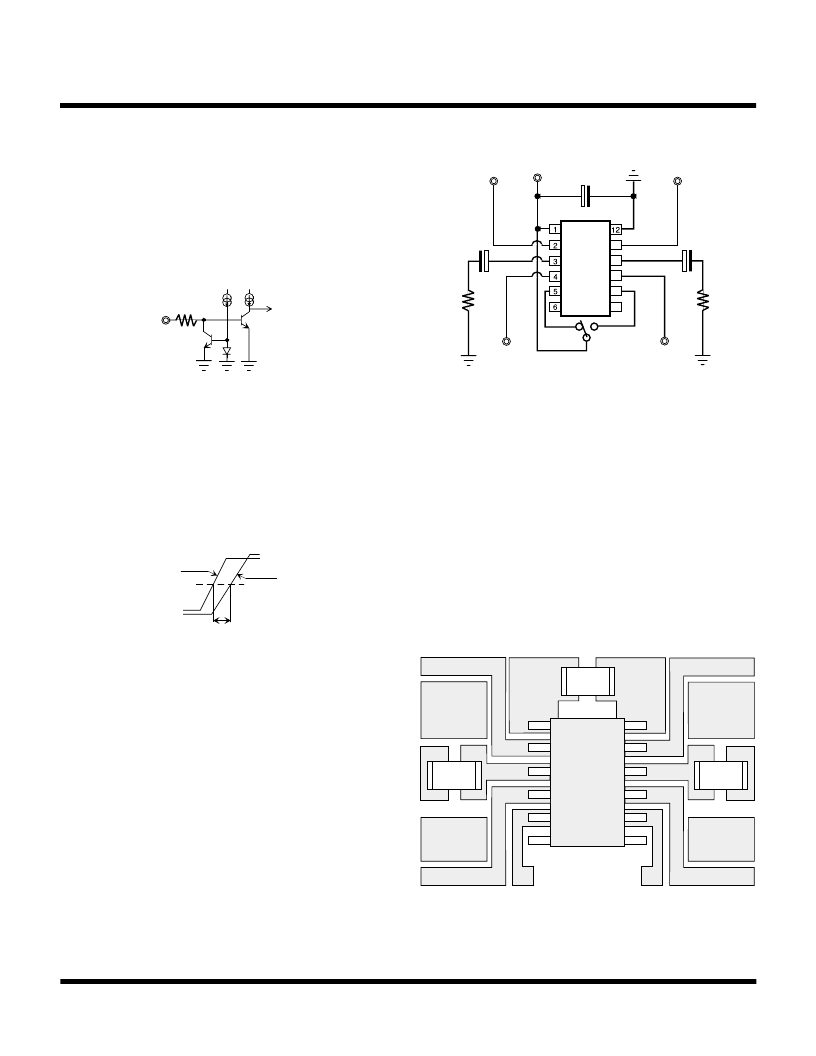- 您現(xiàn)在的位置:買賣IC網(wǎng) > PDF目錄361483 > TK15329MTL (TOKO INC) Audio Analog Switch PDF資料下載
參數(shù)資料
| 型號(hào): | TK15329MTL |
| 廠商: | TOKO INC |
| 元件分類: | 多路復(fù)用及模擬開(kāi)關(guān) |
| 英文描述: | Audio Analog Switch |
| 中文描述: | DUAL 2-CHANNEL, AUDIO/VIDEO SWITCH, PDSO12 |
| 封裝: | PLASTIC, SSOP-12 |
| 文件頁(yè)數(shù): | 11/16頁(yè) |
| 文件大小: | 209K |
| 代理商: | TK15329MTL |
第1頁(yè)第2頁(yè)第3頁(yè)第4頁(yè)第5頁(yè)第6頁(yè)第7頁(yè)第8頁(yè)第9頁(yè)第10頁(yè)當(dāng)前第11頁(yè)第12頁(yè)第13頁(yè)第14頁(yè)第15頁(yè)第16頁(yè)

June 1999 TOKO, Inc.
Page 11
TK15329
KEY INPUT CIRCUIT
1ch and 2ch is separate action by each control keys. Figure
11 is an equivalence circuit of key input. If two keys are low
level or high level at the same time then the output is floating
condition. (See Terminal DC Voltage and Circuit table on
page 9).
SWITCHING TIME
This time is the signal change response time compared to
the control key input signal. Figure 12 illustrates the timimg
chart. T = 2
μ
s typically.
APPLICATION
Figure 13 illustrates an example of a typical application.
The standard application is to use direct coupling at the
inputs and capacitor coupling at the outputs of the
TK15329M. For characteristics of distortion and dynamic
range versus R
, refer to the graphs in the Typical Perfor-
mance Characteristics. The TK15329M can also be used
with direct coupling, but the characteristics will get worse
(distortion, etc.). If capacitor coupling is desired, then it is
recommended to use built-in type biased circuitry of the
TK15327M. DC input bias voltage of TK15327M is V
CC
/2 V.
APPLICATION INFORMATION
Figure 11
Figure 12
Figure 13
Figure 14
CROSS TALK (ISOLATION AND SEPARATION)
Figure 14 is an example of a layout pattern. In the
application of the TK15329M, the following must be
considered. Because of the high impedance at the inputs,
the capacitors can act as antennas to each other. If the
parts are bigger, and the space between the capacitors is
too narrow, then cross talk will increase. Therefore, when
designing the printed circuit pattern, separate the input
capacitors as far as possible and use as small a part as
possible (e.g., surface mount types, etc.).
Key in
to Logic
Key in
Bch (Ach)
SW out
50%
Ach (Bch)
t
1OUT
VCC
GND
2OUT
1KEY
2KEY
1AIN
1BIN
2AIN
2BIN
+
RL
10 μF
1Bin
11
10
9
8
7
2 Bin
1Key
2Key
+
RL
10 μF
+
33 μF
1Ain
2Ain
相關(guān)PDF資料 |
PDF描述 |
|---|---|
| TK15329 | Audio Analog Switch |
| TK15329M | Audio Analog Switch |
| TK15400MTL | 75 OHM VIDEO LINE DRIVER |
| TK15400 | 75 OHM VIDEO LINE DRIVER |
| TK15400M | 75 OHM VIDEO LINE DRIVER |
相關(guān)代理商/技術(shù)參數(shù) |
參數(shù)描述 |
|---|---|
| TK15329MTL/329 | 制造商:TOKO 制造商全稱:TOKO, Inc 功能描述:Audio Analog Switch |
| TK15400 | 制造商:TOKO 制造商全稱:TOKO, Inc 功能描述:75 OHM VIDEO LINE DRIVER |
| TK15400M | 制造商:TOKO 制造商全稱:TOKO, Inc 功能描述:75 OHM VIDEO LINE DRIVER |
| TK15400MTL | 制造商:TOKO 制造商全稱:TOKO, Inc 功能描述:75 OHM VIDEO LINE DRIVER |
| TK15400MTL/400 | 制造商:TOKO 制造商全稱:TOKO, Inc 功能描述:75 OHM VIDEO LINE DRIVER |
發(fā)布緊急采購(gòu),3分鐘左右您將得到回復(fù)。